Winter boots are critical for cold weather.
Our hands and feet have a large surface area relative to their size; that’s why they get cold quickly. To make matters worse, when our body gets cold, it restricts blood flow to our hands and feet first to keep our core warm.
Having cold feet sucks.
Searching for the Best Winter Boot for Wilderness Living
I’ve been experimenting and considering various options for the best winter boot to have in a long term survival scenario.
I used to work in a big-chain outdoor retail store (similar to REI) and customers would ask me what was the best winter boot we sold. I couldn’t point them to a great cold weather boot for the outdoors, despite the store being located in a city with harsh winters. It sold good enough winter boots for city use, or day hike use, and only one or two options that could work in a multi-day outdoor trip.
Challenges for footwear in cold weather
There are many obstacles to keeping our feet warm and dry: they are in contact with the ground most of the time, which means that they are constantly exposed to snow, ice, water, and the cold ground. Feet are also relatively far from our core so our blood is not as warm by the time it reaches the feet.
Circulation
Our feet don’t have much muscle mass, so they can’t produce much heat; once they get cold, they generate even less.
Feet are very dependent on blood circulation for warmth (Kuklane 2009). This means that a truly warm boot should encourage circulation.
Warm Body Core
It doesn’t matter how well insulated your feet are if your body is cold. A cold core will make your feet cold. So your first line of defence against cold feet is having a well insulated core. Cold feet are often caused by general cold.
On the other hand, if your winter boots are not insulated enough, then your feet will feel cold despite having adequate winter clothing.
Exercise
Exercising for 10 minutes or more can rewarm your toes.
A technique that has worked well for warming up my toes is to grab on to a tree and swing one leg at a time for a few sets to increase blood circulation through centrifugal force.
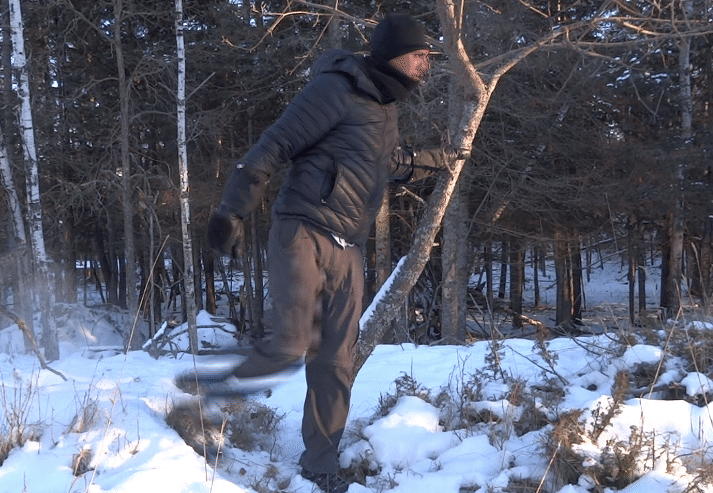
Moisture
Often the feeling of cold feet is caused by having moist feet, which causes low skin temperature.
Moisture comes from either the inside or outside of our winter shoes. Outside moisture is easy to manage with a waterproof winter shoe, but inside moisture is more tricky.
The challenge is that even in the cold our feet sweats from 3 grams per hr. during rest to 15 g/h during hard work. During very heavy exercise sweat may reach 30 g/h, even in cold (Kuklane 2009).
Over prolonged use, moisture will accumulate. Damp socks and shoes don’t insulate well, so the moisture must be managed somehow.
Ideally our sock and liner system will wick moisture away from our skin. Socks and liners are the best ways of managing inside moisture: we can change our moist socks and liners for dry ones.
Socks
Not only are socks and liners important for insulation, they are the main means of removing moisture from our shoes; it’s a system: boots-liners-socks
Cold weather wool socks absorb the most moisture while still keeping your skin dry (up to a point). What makes wool so special is that it retains the moisture in its core, keeping the fibres that touch your skin dryer.
I wear Canadian military cold weather wool socks inside wool liners. Those socks seem more durable than mountaineering wool socks and are cheaper.
Often, wearing two pairs of socks doesn’t increase warmth because it compresses the sock’s insulation and reduces blood circulation.
Removable Liner and Insole
Removable liners and insoles are a must for a winter boot made for over-night or multi-day use. If your cold weather boot has no removable liner then it’s not meant for prolonged use.
Removable liners allow you to dry your boots every night by a fire or wood stove.
Another option is to wear your liners when sleeping or to keep them inside your sleeping bag (albeit with the risk of decreasing the insulation of your bag over time by getting it moist, or sleeping with cold feet if the liners are damp).
Drying in the field is extremely difficult with boots that lack a removable liner, and that’s why you should avoid them at all cost (dry moss, toilet paper, or hot rocks inside a sock can help, careful not to melt the sock/boot).
Ideally, you can have two pairs of liners to exchange throughout the day or each day, while you dry your other pair. A second pair of liners could be dried on your person among your inner layers of clothes when on the move (or if having a fire is not possible).
If you intend to dry your boot liners inside a hot tent at night it’s best to dry them by the stove and then store them in a place that won’t absorb moisture before going to sleep. Otherwise the moisture from your breath and vapor from cooking, will be absorbed by the liners throughout the night. A military study found that often, liners actually absorb moisture when hung up in a hot tent overnight.
One of the best wool boot liners available is made by the same Canadian company (Raber Gloves) that makes the Arctic mitts for the Canadian military. The wool liner has two layers (one inside the other) that can be spread for faster drying (see below).
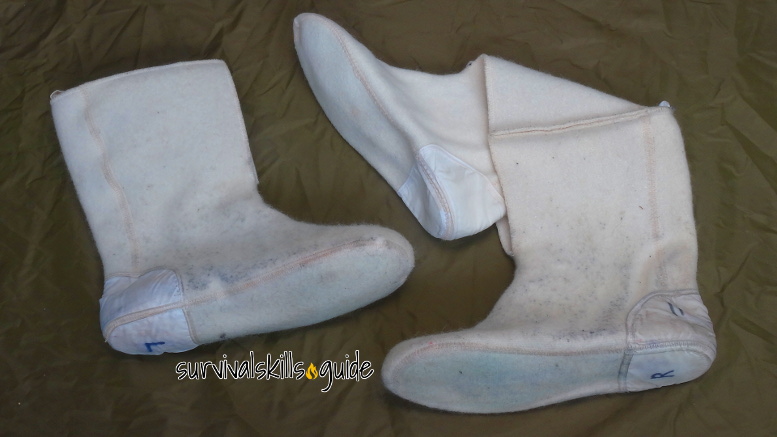
Features of the Ultimate Winter Boot:
Flexible Sole
One of the best ways of warming your feet is through increased blood flow. Walking in shoes with flexible soles makes your foot muscles move more; thus, increasing blood circulation and muscle created heat. It’s one of the reasons why mukluks feel so warm.
Fire Resistant
In winter, people get close to camp fires. Obviously it’s best not to do it, but it’s one of those things that happens… Leather comes too mind but Nomex and other fire resistant materials would work well to protect boots from embers.
Waterproof or Breathable Winter Boots?
The Canadian Military has asked themselves the same question. They compared waterproof mukluks and breathable mukluks: they coated the inside of the standard issue mukluks to make them waterproof and conducted lab and field tests.
The waterproof mukluks gained 20 to 30% more moisture from sweat. However the total difference in moisture was only a few grams, and it was not considered important. Another thing observed was that the waterproof shoe retained slightly more heat.
At the end of the day no difference between the amount of moisture in both waterproof and breathable mukluks was perceived by the people wearing them.
Depending on how cold your winters are and how often you do activities near water you might opt for a breathable or a waterproof boot.
Most winter boots nowadays are marketed as “waterproof” because when people use them in the city and during the shoulder seasons, slush is common. If you’ll be walking around water a lot and getting your boots wet is likely, then waterproof boots are more appropriate.
Only rubber boots will stay waterproof for a long time. Pacboots and other boots that depend on inner coatings or Gore-Tex to stay waterproof, likely won’t stay watertight for long and will leak if submerged in water.
The temperature range around the freezing point of water is the most challenging because of changing weather. If you want boots that you can use during the shoulder seasons as well, then waterproof boots make more sense.
Another advantage of waterproof boots is that they are very wind proof as well.
In extreme cold conditions, a breathable boot would accumulate less moisture. When it’s very very cold, snow doesn’t melt when it touches your boots. If you’ll be in an environment consistently below 15°F (-10°C) and you won’t encounter slush or water then a breathable boot is better. If you are going in and out of a warm shelter, snow must be removed from your boots though, otherwise it will melt and soak them.
Because of Murphy’s law and the fact that I would use my winter boots in the shoulder seasons and often next to water, I prefer waterproof boots.
The Canadian military has taken the same approach and recently chosen waterproof mukluks.
Proper Fit
Having a boot that fits properly is super important. If it’s tight it will reduce circulatory heat and make your feet cold (a tight fit can reduce insulation by almost 10%). On the other hand, if the winter boot is too big then warm air will escape, making your feet cold, and will likely make your sock slip off your foot.
A tip is to try your boots with the same liners and socks that you intend to use before buying them (keep in mind that feet swell after lots of activity).
Compatible with Snowshoes
Winter boots should work with snowshoes and be comfortable to use for extended periods. Boots that are heavy and rigid aren’t good for this. Additionally, some boots might be too big to fit in snowshoe bindings (I’m looking at you “-40°F boots“).
Lightweight
Being tired decreases our ability to fight off the cold. Having lightweight boots is important because even a 3.5 oz (100g) increase in footwear weight will increase our oxygen consumption by 0.7-1.0%. Footwear weight is equivalent in energy cost to five or more times the weight carried on our back.
Breathable Winter Boots
US Military Mukluks
The Wellco N-1B military mukluks are fire resistant, and are widely available. But you must buy the liners separately, and they are short and not as good as the Canadian mukluks liners.
Canadian Military Mukluks
The Canadian military mukluks have an upper of synthetic materials, so they aren’t fire resistant, if an ember lands on it, it will get a hole. I own a pair and I really like the insoles and wool liners. A mesh insole keeps the felt insole separated from the moisture at the bottom of the boot.
Note: In a recent 100-day solo winter survival trip these boots were my main boots. They served me well although I would have appreciated thicker boot liners. I actually separated my extra pair of boot liners and combined them with another pair to make an extra thick liner. The nice thing about this mukluks is that they can accomodate a lot of bulk without constricting your feet. One of the plastic “D”s that hold the leaces broke, and the side of the sole started to delaminate, but they served me well.
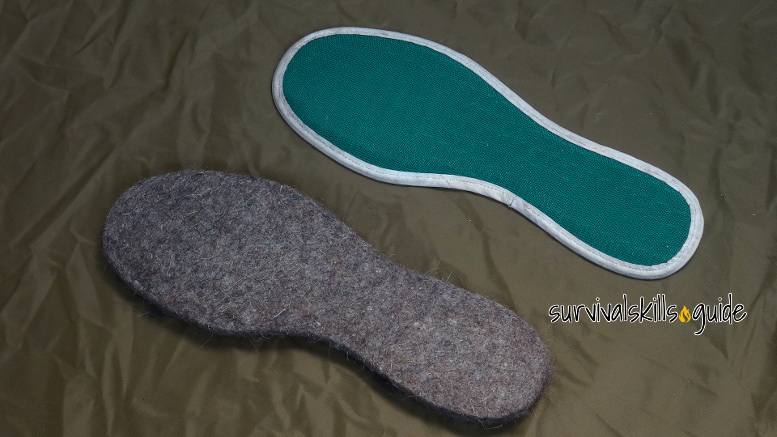
Steger Mukluks
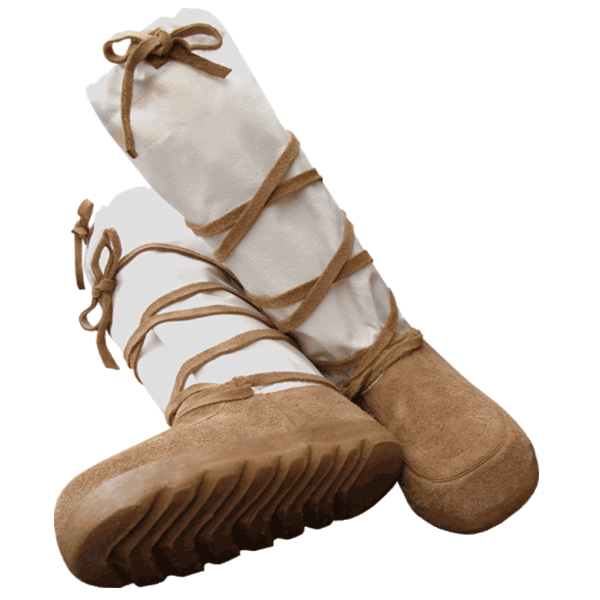
Steger mukluks are inspired by traditional mukluks but have a synthetic sole for added durability. These would also make a great choice for a breathable winter boot.
Waterproof Winter Boots
New U.S. and Canadian Military Mukluk
The US and Canadian Forces have adopted a new extreme cold weather boot but it’s not widely available to the public yet. It is supposed to be waterproof yet breathable. As time passes we’ll be able to see more listings popping up on eBay like this one and this one.
NEOS Overboots
Many people swear by NEOS overboots. They are really lightweight and compact and can be worn over a shoe or a boot liner. I own a pair, but after a year of use, I discovered that when submerged in water, they leak. This is fine most of the time, but not great for when I’m canoeing in the fall or when I’m near water.
They don’t include boot liners though, so you have to buy them separately.
Tingley’s
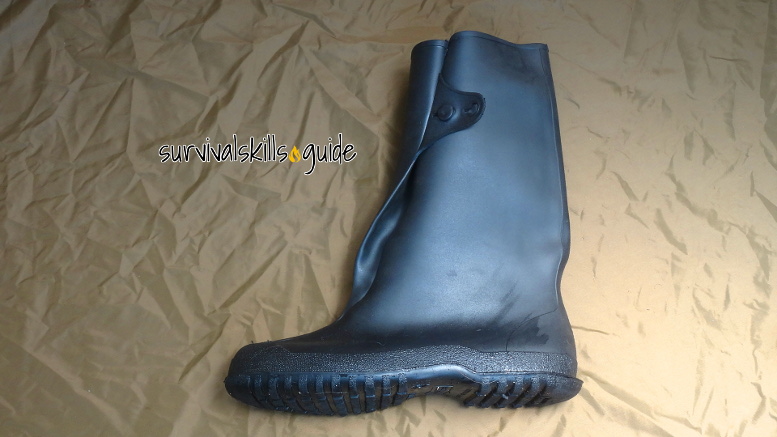
Tingley’s overboots are what I consider the best compromise so far; and they’re affordable too. They are made of rubber and are completely waterproof. A big plus is that they are flexible and can be flipped inside out for drying. This also makes them very comfortable when walking, and increases blood circulation.
I use them with liners and insoles from the Canadian military mukluks.
Note: After a recent 100-day solo winter survival trip I did my Tingleys developed a tiny hole in the “tongue” fold. Now, I would recommend this boots only for times of transition like the fall and spring when the snow is wet.
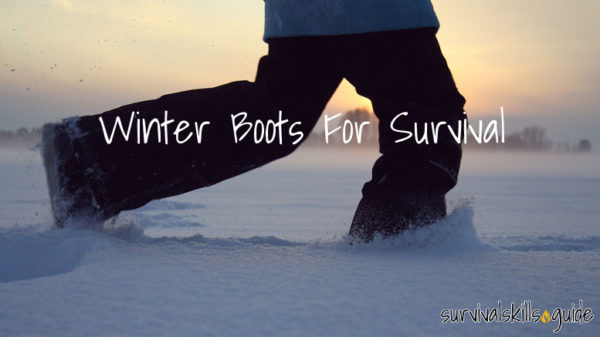
To Wrap Up
Winter boots should have removable liners and insoles. Flexible boots are warmer because of added blood circulation. You should think about it as a system of socks, liners, insoles, and boots. They work together to insulate and absorb moisture to keep your feet warm and dry. And being able to dry or change the components of your boots is a must in multi-day scenarios.
References
KUKLANE, K. (2009). Protection of Feet in Cold Exposure ncbi.nlm.nih.gov/pubmed/19531910
Physiological Comparison of Two Types of Duffel Sock for use with the Canadian Forces Mukluk apps.dtic.mil/dtic/tr/fulltext/u2/a031977.pdf
The use of Impermeable Mukluks in the Cold: An Initial Investigation. National Defense Canada cradpdf.drdc-rddc.gc.ca/PDFS/unc160/p92986_A1b.pdf
A Review of Footwear for Cold/Wet Scenarios. National Defense Canada apps.dtic.mil/dtic/tr/fulltext/u2/a264870.pdf

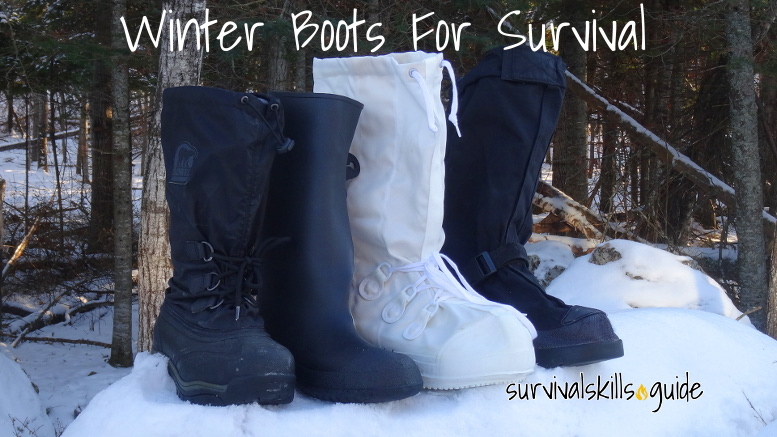
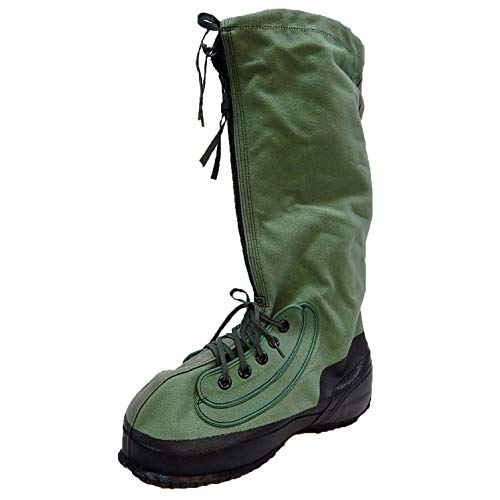
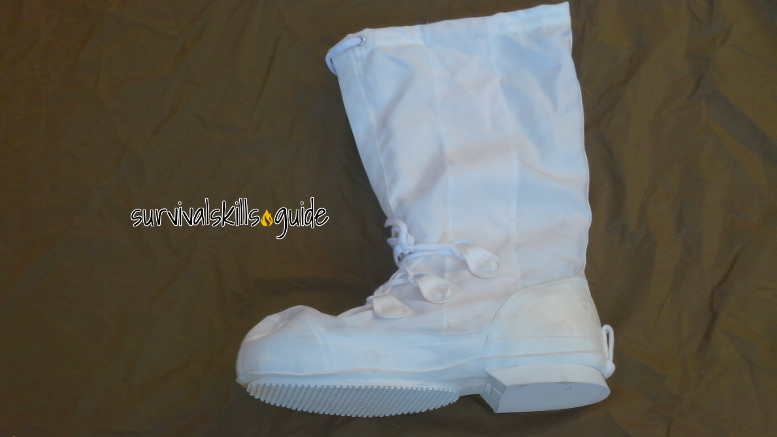
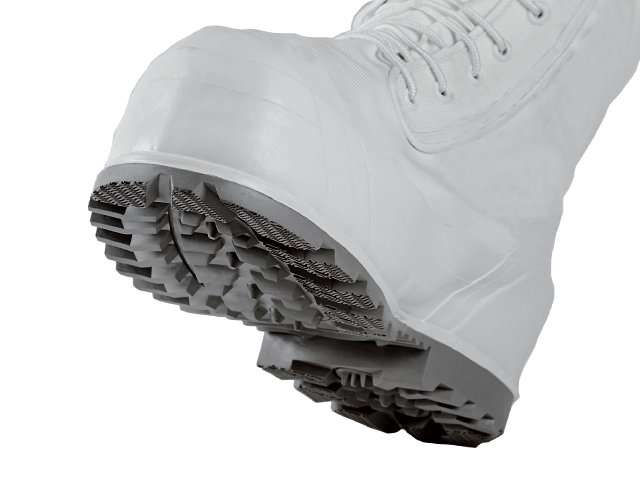

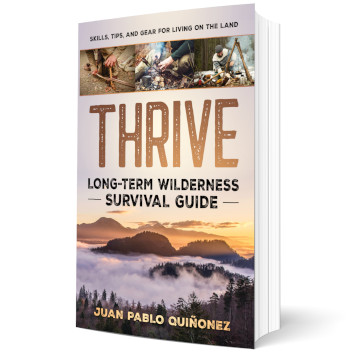
Hey. You mention a Canadian company that makes one of the best wool boot liners. What’s the name of that company? Thanks!